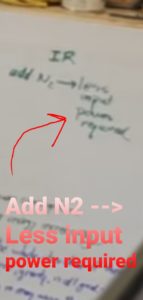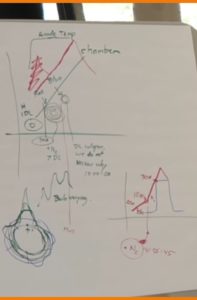The following has been submitted by an ECW reader.
UPDATE: The author of this article has submitted the following update:

The above image was obtained from a YouTube video in which Monty Childs was sharing his computer screen. It provides additional evidence that in some of their experiments they are using a heavy Tungsten alloy, specifically the alloy WNiFe. They seem to have been using this alloy in the experiment featured in many of their videos that shows their anode melting. During that experiment they were utilizing a mixture of N2 and H of the ordinary isotopic ratio to induce exothermic nuclear reactions and transmutations. Please note that this exact alloy is not required. Monty Childs has specified that all materials produce some transmutations and excess heat but some are more reactive than others.
Please note that the reason they describe the anode as “blue” is unknown. Two possibilities are as follows. First, in some of their experiments the anode has changed color after a run. It’s possible that the anode turned blue and they are using that as a description. The second possibility is that they are using an alloy of WNiFe that is LANTHANATED. Tungsten welding rods that contain 2% lanthanum are described as being blue. If they were using a lanthanated anode, it might allow the plasma to ignite at a lower current and allow for the current capacity of the anode to be increased. However, in some videos Monty Childs indicates that Lanthanum was not in the reactor but was produced as a transmutation product. This makes me think that most likely they are not using lanthanum in their electrode.
++++++++++++++++++++++++++++++++++++++++++++++++++++++++++++++++++++++++++++++++++++++++++
The SAFIRE Plasma Reactor: The Breakdown of a Miracle in Seven Steps
By: An Addict of Aureon Energy Ltd. and Self Organizing Plasmas
The SAFIRE Project represents a revolutionary energy technology that’s also capable of producing transmutations, remediating nuclear waste, and perhaps much more. Although the verified, repeated results Montgomery Childs, Michael Clarage, and the other members of their core and extended team have produced are astounding, the basic concept of what they are doing is simple. There’s no big mystery about how their technology works. Yes, that’s right. By reviewing their videos, reading their papers, listening to their interviews, studying other papers about self organizing plasmas, and checking out the work of an extended list of other inventors who have built devices utilizing the same phenomena, all the most critical pieces of information become obvious. This essay is an attempt to present the most fundamental pieces of know how in a concise and easy to understand manner.
The Reactor
The SAFIRE Plasma Reactor is a sophisticated engineering marvel connected to an array of sensors and data acquisition equipment. However, the basic design it utilizes to produce a self organizing plasma (man-made ball lighting, complex space charge configuration, macro-EVO) is very straightforward. Two flat circular cathodes of a large surface area are positioned at equal distances on opposite sides of a central spherical anode. This spherical anode can be solid or hollow and either will “work” to produce excess heat and transmutations. A hollow anode can be useful because deionized water can be pumped through the interior for cooling, sensors of various types may be placed inside, and pressurized hydrogen or deuterium can be pumped through the interior resulting in a migration to the exterior surface. However, hollow anodes are not required. Solid anodes work and are cheaper and simpler.
A multitude of materials for the anode will work to produce excess heat, according to Montgomery Childs, the Director of the Safire Project. However, we know that in one of their patents an iron nickel alloy with at least 20% nickel is listed. Further research and an analysis of their published videos indicates that in some cases they are using an alloy composed of at least three elements: Tungsten, Nickel, and Iron. It’s almost certain they’ve tested pure anodes of each of these materials. As we know, Tungsten seems to react very energetically (sometimes vaporizing) when exposed to a self organized plasma. This effect has been witnessed in a variety of exotic energy systems. Logic dictates that a combination of elements that may help produce a balance – producing copious energy while preventing short term destruction of the anode – would be useful.
A few examples of Tungsten Nickel Iron alloys can be found on the following site:
https://www.albmaterials.com/tungsten-nickel-iron-w-ni-fe-high-density-alloy-ball.html
[In one experiment, if I’m interpreting the information from one of their videos correctly, they started with a W-Ni-Fe alloy and the examination of the anode from a third party detected the Tungsten, Nickel, and Iron starting elements and the following many of which are transmutation products if not all of them: Carbon, Barium, Calcium, Titanium, Zinc, Chromium, Sulfur, Chlorine, Calcium, Potassium, Lanthanum, Cerium, Silicon, Tin, etc.]Personally, I’d guess they’ve also tried various super alloys like the following but this is just a guess.
The Gaseous Environment
The SAFIRE Project is able to introduce a number of different gases into their reactor including hydrogen, deuterium, helium, argon, nitrogen, oxygen, and air. By observing their videos closely it’s plain to see they are often using a combination of hydrogen and nitrogen and sometimes a combination of hydrogen, nitrogen, and argon (we know this last combination has been tested due to the notes hanging in Monty Childs garage). Most of the time in the videos it seems as if they are testing various ratios of hydrogen and nitrogen, as notes from his garage indicate that the introduction of nitrogen triggers the production of copious double layers and reduces the input power required. We know they have tested many different ratios of hydrogen and nitrogen from the notes in their hands. From the display of their mass spectrometer it seems that this combination was used during certain experiments that produced surges of excess power that melted anodes.


Although they most probably do not add water intentionally, the screen of their mass spectrometer shows that small but significant quantities of water vapor are in their system. This is likely almost inevitable unless they perform an intensive “bake out” procedure. The importance of the percentage of water vapor in the low pressure (a rough estimate might be between 10 and 20 Torr) plasma environment is unclear. Perhaps they will elaborate on this at some point. Interestingly, it seems that hydrogen and not deuterium is the gas they use most frequently. This represents another aspect of the simplicity of this phenomena: hydrogen of the ordinary isotopic ratio works. Pure deuterium, which is more expensive, is not required.

To provide a specific example, here are the atomic mass units and percentages from their mass spectrometer read out during one of their experiments. You can find many such screens during their videos.

2 (H2) 34.6%
3 (Likely the H3+ ion which is common in DC plasmas) 4.08%
28 (N2) 43.3%
29 (Likely a molecule consisting of two different isotopes of nitrogen 15N – 14N) 11.0%
14 (N) 5.83%
18 (H2O) 1.17%
The result if you add up the percentages above equates to 38.68% hydrogen and 60.13% nitrogen with 1.17% water.
Electrical Input, Double Layers, and Massive Excess Energy
The SAFIRE Reactor utilizes direct current (DC) electricity with very low ripple, meaning that it’s very clean. The cleanliness of the input may or may not be important: for all we know the application of “dirty” or pulsed DC or the application of a secondary signal (AC or DC) over the first may even be useful. Yet simple direct current works. This is great news because there’s no “magic frequency” that’s required. Before we continue, it should be pointed out that the voltage and the current can be independently controlled, and the input power is current restricted. Once a suitable voltage is applied that ignites the plasma and is deemed sufficient for the experiment, the current is increased. As the current is increased various plasma regimes are produced. After moving past the appearance of tufts, growing tufts, and spinning tufts, the beautiful double layers start to form around the anode. These large, expansive double layers are impossible to miss and represent alternating layers of electrons and ions. Importantly, they also act as (or produce) electromagnetic containment fields that eliminates the need for the powerful external electromagnets used in hot fusion experiments. This is yet another feature of this phenomena that proves its simplicity and extreme utility. Because these self organizing structures do the work of producing their own containment fields, the complexity of building a plasma reactor utilizing this technology is reduced by at least an order of magnitude. As Montgomery Childs has stated, paraphrasing, they give the plasma the conditions they think it would like and let it do all the work for them. This is unlike traditional hot fusion systems in which you do all the work, spend billions of dollars, and the plasma gives back little to nothing – barely reaching break even and certainly not proving economically viable.
When you increase the current further, the large nested double layers collapse towards the anode and form one intense double layer with an extremely sharp voltage gradient just off the surface. The result is a brilliantly glowing yellow-orange ball of light producing copious excess energy in a variety of forms of heat, light, electricity, and electromagnetic fields. Most of these emissions will convert rapidly into a “thermal response” producing heat that could be captured to boil water, produce steam, and turn a generator. It’s also during this time period that transmutations in real time are captured with an optical spectrometer and elements are also transmuted on and inside of the anode. As if a miracle had transpired, all of this happens with no hard radiation being detected.


The control of this plasma regime in which the double layers collapse close to the anode producing what looks like a brilliant star is critical. We know that The SAFIRE Project has melted at least one anode and other companies utilizing self organizing plasmas have destroyed a variety of materials. Also, you do not want to move past the negative resistance regime and enter a true arc discharge in which the plasma ball will vanish and the experiment will end. Basically, when any material is sitting within the core of man-made ball lighting or an Exotic Vacuum Object (EVO) it can suffer tremendous stress that can result in melting or even vaporization. Likely, The SAFIRE Project have discovered optimal combinations (of gas pressures, input power, elements in the anode) that can prevent such damage from happening. However, there are other solutions that they may not have tested yet. This includes utilizing a different electrode configuration in which there is no central anode. In this setup there would be a cathode on one end of a tube (perhaps quartz) and an anode on the other end. Existing literature going back many decades explain how in such a setup (if the parameters of the system are correct) a self organizing plasma will start to form on the anode or cathode. As the current is increased, the self organizing plasma will start to slowly move away from the electrode, attached only by a tether. Eventually, when this structure reaches it’s maximum level of self organizing it will detach from the electrode completely. At this stage it is a “free floating fireball.” The benefit of this setup would be that the plasma ball would not be in physical contact with any component of the reactor. This means there would be nothing to destroy. However, this also means that the fuel would be composed of the gases added to the reactor and whatever nano-particles are sputtered off the electrodes. When such a free floating plasma ball has formed, it can be detected both visually and on an oscilloscope due to the ion acoustic oscillations it will produce. If the power is adjusted further, the fireball will actually blink on and off, casting off double layers and rebuilding them only to repeat the process over and over. The author hopes SAFIRE will not only continue testing their current configuration but also the one described above as a potential way of overcoming any material science limitations.
(The author would like to speculate that a “free floating fireball” as described above might be capable of being pushed to a higher level of self organization (thus more excess energy) than one wrapped around a physical anode. In this case, the core of the “free floating fireball” becomes positively charged and is indeed a virtual anode. Also, in such a setup higher pressures might induce the fireball to compress smaller in size resulting in a higher plasma density, which might or might not be favorable.)
The Breakdown of a Miracle
Here’s a concise list of what you need to know about SAFIRE. Please note that there are obviously many standard engineering issues that would need to be sorted out, but the basic effect is not highly complicated. In fact, I’d go so far as to say it’s far more simple than any traditional LENR technology (electrolytic or gas loading) or hot fusion technology.
1) Two large surface area disc shaped copper cathodes. If their distance from each other can be adjusted on the fly that is a plus. The use of copper may not be an absolute requirement. For example, aluminum may work or, if you want to get exotic, a diamond coated, hydrogen doped electrode with a negative electron affinity.
2) A solid or hollow anode of any number of materials including nickel, iron, and tungsten. An alloy with all these elements might be even more useful. Additions of molybdenum and chromium might be interesting as well. Make sure to degrease and clean the surface well because oil and other contaminants could make generating a stable plasma difficult.
3) A low pressure gaseous environment with varying ratios of hydrogen and nitrogen or hydrogen, nitrogen, and argon. A small bit of water from the atmosphere may or may not be important. A good pressure range might be between 10-20 Torr.
4) A current restricted power supply in which the voltage and current can be independently controlled. A typical voltage used by SAFIRE might be 600-1000 volts (sometimes higher or lower) and anywhere from a few to 40+ amps. Please note that the required amperage will depend upon the size of your anode. A smaller spherical anode will require less amperage than a large one. The power supply and control system should also be setup in such a way that it could survive surges of massive back currents. The SAFIRE Reactor can produce surges of up to 12 million watts that can destroy power supplies.
5) A careful and gradual increase in current after igniting the plasma with a sufficient voltage. Eventually, after passing through several other plasma regimes, large nested double layers will be produced. However, it’s the phase in which they collapse to one double layer close to the anode that triggers the excess heat and transmutations.
6) Equipment to monitor everything! Countless types of equipment could be mentioned here. However, I’d just like to mention that the idea of being able to watch the ion acoustic waves show up on an oscilloscope during the transition to the negative resistance regime (when the double layers show up and the current/voltage relationship flip flops) sounds incredibly exciting to me.
7) Safety gear! Safety protocols! Only PROFESSIONALS that are QUALIFIED and have a SUITABLE LABORATORY should ever dabble in this type of experimentation. Simply put, if you don’t know what you’re doing there are a gazillion ways to get hurt, severely injured, or worse.
The Dream of Self Sustain
Montgomery Childs already hinted during one of his presentations that in the future the cathodes of the SAFIRE reactor may not be required, because they think that the plasma ball itself is producing most of the electrons it needs to sustain itself from the general environment of the chamber. I think this is a simple way of saying that in the future the reaction might become self sustaining in that once a certain amount of input power has been applied to create the self organizing plasma that the plasma ball itself might be able to continue existing without externally applied power. This is different than simply closed looping the system by using the heat to produce steam, turn a generator, and then re-direct a small portion of that electrical output back into the power supply. What I’d like to point out is that such a self sustained mode of operation might be easier (although this would need to be tested) with a free floating plasma ball rather than one that is wrapped around an anode. This is because I suspect that at the level of self organization that would allow for the plasma ball to power itself the anode would be damaged or possibly destroyed. If a plasma ball floating between one anode and one cathode were self sustaining, there would be no damage because it wouldn’t be touching anything.
One major reason I believe such a self sustaining mode is possible is due to the fact there are existing experiments in mainstream scientific literature in which such a free floating plasma ball (created by a DC discharge) is maintained by simply cutting off the external electrical power to the circuit, keeping the circuit closed, sometimes placing a capacitor/resistor in the circuit, and applying another form of energy. For example, using a resistance heating coil on the cathode to induce thermionic emission or applying microwave or radiowave radiation. If they had been using an optimal fuel mixture with hydrogen, I believe that the heat from the LENR reactions would have been enough to sustain the plasma ball.
Conclusion
The SAFIRE Plasma Reactor is far more complex than what this document describes. To build a reproduction of their large reactor would be quite an undertaking. Yet the basic principles they utilize that result in excess energy and transmutations are simple. Please note that their first system was built in bell jar with various ports added! There is no reason why qualified professionals at university research centers and other suitable laboratories cannot seek to study the astounding and truly PARADIGM SHIFTING properties of self organizing plasmas (macro-EVOs) while the SAFIRE Project races towards the production of their industrial prototypes and commercialization.
The author wishes the SAFIRE Project and all the various companies that are utilizing the phenomena of self organizing plasmas tremendous success. By harnessing the potential of this miracle that’s literally light years beyond the invention of fire, we can rescue our civilization, build a better world for our species, and one day travel the stars to seek a place among the other intelligences in the universe.

